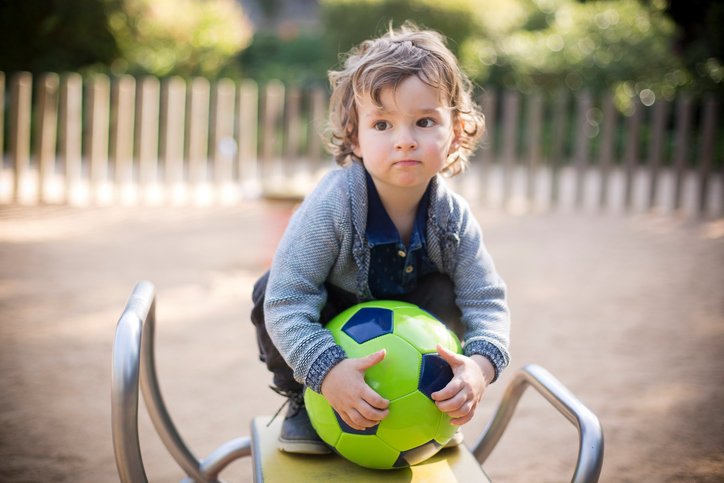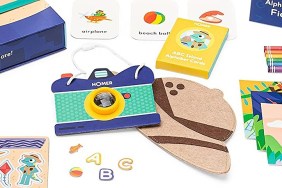In a world full of “smart” toys that take the guesswork out of just about everything and include fun sounds and flashing lights, it’s easy to forget that what toddlers need most of all is time to move and play with no frills toys. A ball is one such toy.
Between the time when a baby learns to sit up and when that baby heads off for the first day of preschool, gross motor skills develop at a rapid pace. Ball skills, or the ability to throw, catch, and kick a ball, develop during this time. These skills reflect how well a child can balance her body in space, coordinate both sides of the body, and interact with the space around her.
When can a toddler throw a ball?
Learning to throw a ball is a gradual process. Toddlers don’t just fire off a powerful throw out of nowhere. They learn to throw and manipulate a ball in stages.
• By 12 months, a baby can roll a ball on the floor independently. At this age, a toddler can also stand and throw a ball (without accuracy) by extending the arm. The toddler might fall after throwing.
• By 18 months, a can stand and throw a ball without toppling over.
• By age 2, a child can throw a small ball in a forward direction using either an overhand or underhand technique.
• By 3 ½ years, a toddler can use the upper trunk and coordinate the arms and legs to throw at a greater distance and hit a target using an underhand throw.
Try this to help your child practice throwing a ball:
It’s important to meet your child where she is when it comes to reaching developmental milestones. If your three-year-old doesn’t show any interest in throwing, stick with rolling and encourage your child to have fun.
• Choose soft balls that are easy to grasp.
• Sit opposite your toddler with legs outstretched.
• Add a favorite stuffed animal to the mix to make it fun.
• Roll the ball back and forth, providing encouragement as you go.
• Move on to rolling to hit a target (e.g. a pyramid of toilet paper rolls.)
• Once your toddler has rolling down, stand up and encourage tossing (overhand or underhand.) Play with a soft beanbag to get the hang of it.
• Encourage target practice by throwing balled up socks into an empty laundry basket.
When can a toddler catch a ball?
Catching a ball is similar to throwing in that it develops in stages. While those rolling games are a great precursor to throwing, they also help your toddler practice catching!
• By 12 months, a toddler can stop and trap a ball between outstretched legs by wrapping her arms around it.
• By 2, a toddler can stand with her arms outstretched in front of her body with her palms up. This is the receiving position. While she won’t catch every ball that comes her way, she will catch some. When she does catch a ball, she’ll bring her arms to her chest to secure it. This is great practice.
• By 3, a child can catch a ball with arms outstretched and palms up without the need to bring it to her chest to secure it.
Try this to encourage catching skills:
Some toddlers flinch or turn away when a ball is thrown their direction. This is a perfectly natural reaction to a round object hurling in a toddler’s direction. Break this skill down into steps to help your toddler master catching.
• Revisit rolling games to help your toddler practice stopping the ball.
• Use balloons to encourage your toddler to work on catching while standing. The slow floating motion and soft touch decreases the worry about a ball hitting your toddler head on.
• Next, use bean bags or small, soft balls to practice catching with outstretched hands.
• Finally, use a large playground ball. Be sure to use a soft toss to encourage attempts to catch.
When can a toddler kick a ball?
Kicking a ball from a standing position is fun for toddlers, and many toddlers actually skip ahead to this skill.
• By 18 months your toddler has the coordination to stand, lift her foot, and kick the ball. The ball won’t get very far, but this is the first stage of kicking.
• By 20 months your toddler will be able to kick the ball from a stationary position and get some distance.
• By 2 years, your toddler will begin to coordinate both sides of the body. This helps your toddler rotate her trunk to kick for distance.
• By 3 years, a toddler can kick using her leg like a pendulum to launch the ball.
Try this to work on kicking skills:
It takes time for kids to learn to kick a ball while running, but moat toddlers enjoy making the effort to kick from a standing position.
• Balloons also come in handy for this skill, as they are lightweight and easy to kick.
• Roll a ball toward your toddler to encourage kicking a moving target.
• Get out and play!
Ball skills require time and practice to master, and they are best learned at your toddler’s own pace. Resist the urge to enroll in toddler sports classes and make sure your toddler has plenty of time to move and play outside, instead.








